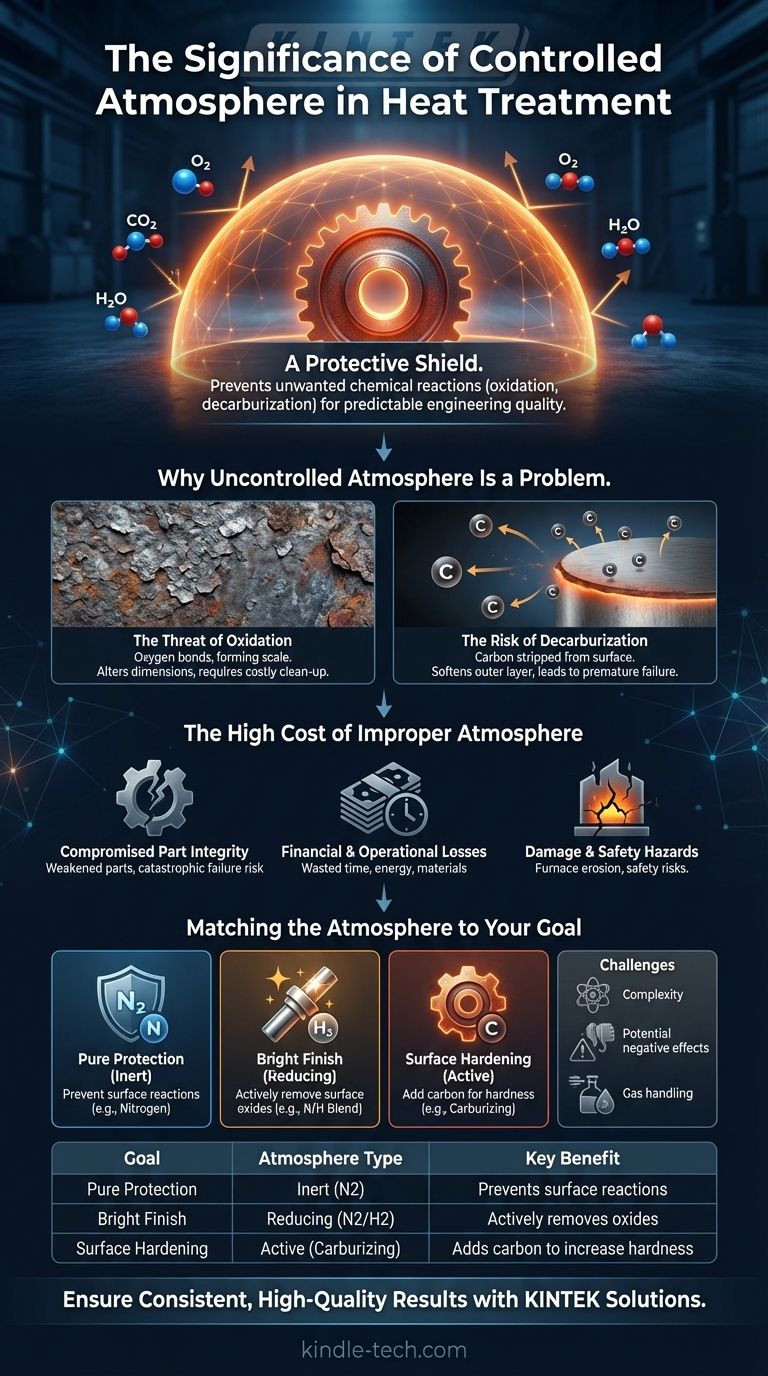In essence, a controlled atmosphere is a protective shield. During the high temperatures of heat treatment, a metal's surface is highly reactive with the air around it. A controlled atmosphere replaces the ambient air with a specific, engineered gas mixture to prevent these unwanted chemical reactions, such as oxidation and decarburization, ensuring the final product retains its intended metallurgical properties.
The true significance of a controlled atmosphere is not merely to prevent rust; it is to exert precise chemical control over a material at its most vulnerable state. This transforms heat treatment from a simple heating process into a predictable engineering function, guaranteeing the part's final quality, strength, and safety.

Why an Uncontrolled Atmosphere Is a Problem
When a metal part is heated to several hundred or even a thousand degrees, the ambient air becomes a significant threat. The oxygen, carbon dioxide, and water vapor present in normal air will aggressively react with the metal's surface.
The Threat of Oxidation
Oxidation is the most common unwanted reaction. At high temperatures, oxygen in the air rapidly bonds with the metal, forming a layer of scale or oxide on the surface.
This scale can alter the part's dimensions, create a rough surface finish, and in many cases, must be removed through costly secondary processes like sandblasting or chemical pickling.
The Risk of Decarburization
For steels, decarburization is a critical concern. This is a process where carbon atoms at the surface of the steel react with the atmosphere and are stripped away.
Since carbon is the primary element that gives steel its hardness and strength, losing it from the surface makes the outer layer soft and weak. This can lead to premature failure of the component under stress.
The High Cost of an Improper Atmosphere
Failing to properly manage the furnace atmosphere is not a minor oversight; it has severe consequences that ripple through the entire manufacturing process and beyond.
Compromised Part Integrity
The most immediate result is a compromised part. A component with a decarburized surface or one that has been altered by oxidation will not perform to its engineered specifications.
This leads to rejected batches, which is costly, but far worse is the risk of a weakened part making it into a final assembly. In industries like aerospace or automotive, such a failure could be catastrophic.
Financial and Operational Losses
From a business perspective, the impact is significant. Improper atmospheric control results in wasted time, energy, and materials.
Entire batches of parts may need to be scrapped or re-treated, causing production delays and direct financial loss.
Damage and Safety Hazards
A poorly managed atmosphere can also damage the furnace itself. Certain reactive gases can erode the electric heating elements or internal insulation, leading to expensive repairs.
Furthermore, the use of combustible or reactive gases without proper control creates a significant safety hazard for employees.
Understanding the Trade-offs and Challenges
While essential, implementing and managing a controlled atmosphere is not without its own set of complexities and potential downsides. An objective view requires understanding these challenges.
Complexity and Cost
Creating a controlled atmosphere requires additional equipment, including gas storage, mixing panels, and sophisticated monitoring systems. This adds to the initial investment and operational complexity of the heat treatment process.
Potential for Negative Effects
If not managed correctly, the protective atmosphere itself can cause problems. As some research notes, certain atmospheres can lead to a rough or non-bright surface finish or even contribute to the erosion of furnace heating elements over time.
Gas Handling and Recovery
The gases used, such as nitrogen and hydrogen, have specific storage and handling requirements. There are also challenges and costs associated with gas usage efficiency and processing the recovery of reducing gases.
Matching the Atmosphere to Your Goal
The choice of atmosphere depends entirely on the material being treated and the desired outcome. The key is to select the right tool for the job.
- If your primary focus is pure protection: An inert atmosphere of pure nitrogen or a nitrogen/hydrogen blend is used to blanket the part, preventing any reaction with the surface.
- If your primary focus is a bright, clean finish: A reducing atmosphere, often containing a higher percentage of hydrogen, is used to actively strip away any trace surface oxides that may form.
- If your primary focus is surface modification (e.g., carburizing): An active atmosphere is used, which is intentionally engineered with specific levels of carbon-carrying gases to add carbon to the surface of the steel, hardening it.
Ultimately, mastering the atmosphere transforms heat treatment from an art into a precise and repeatable science.
Summary Table:
| Goal | Atmosphere Type | Key Benefit |
|---|---|---|
| Pure Protection | Inert (e.g., Nitrogen) | Prevents surface reactions |
| Bright Finish | Reducing (e.g., Nitrogen/Hydrogen) | Actively removes surface oxides |
| Surface Hardening | Active (e.g., Carburizing) | Adds carbon to increase hardness |
Ensure your heat treatment processes deliver consistent, high-quality results. KINTEK specializes in lab equipment and consumables, providing reliable solutions for precise atmospheric control in your laboratory. Our expertise helps you prevent costly part failures and guarantee metallurgical integrity. Contact our experts today to discuss how we can support your specific laboratory needs.
Visual Guide

Related Products
- 1200℃ Controlled Atmosphere Furnace Nitrogen Inert Atmosphere Furnace
- 1700℃ Controlled Atmosphere Furnace Nitrogen Inert Atmosphere Furnace
- 1400℃ Controlled Atmosphere Furnace with Nitrogen and Inert Atmosphere
- Controlled Nitrogen Inert Hydrogen Atmosphere Furnace
- Vertical Laboratory Quartz Tube Furnace Tubular Furnace
People Also Ask
- How do you make an inert atmosphere? Master Safe, Pure Processes with Inerting
- How we can develop inert atmosphere for a chemical reaction? Master Precise Atmospheric Control for Your Lab
- Why nitrogen is used in furnace? A Cost-Effective Shield for High-Temperature Processes
- Can nitrogen gas be heated? Leverage Inert Heat for Precision and Safety
- What is meant by inert atmosphere? A Guide to Preventing Oxidation & Ensuring Safety



















